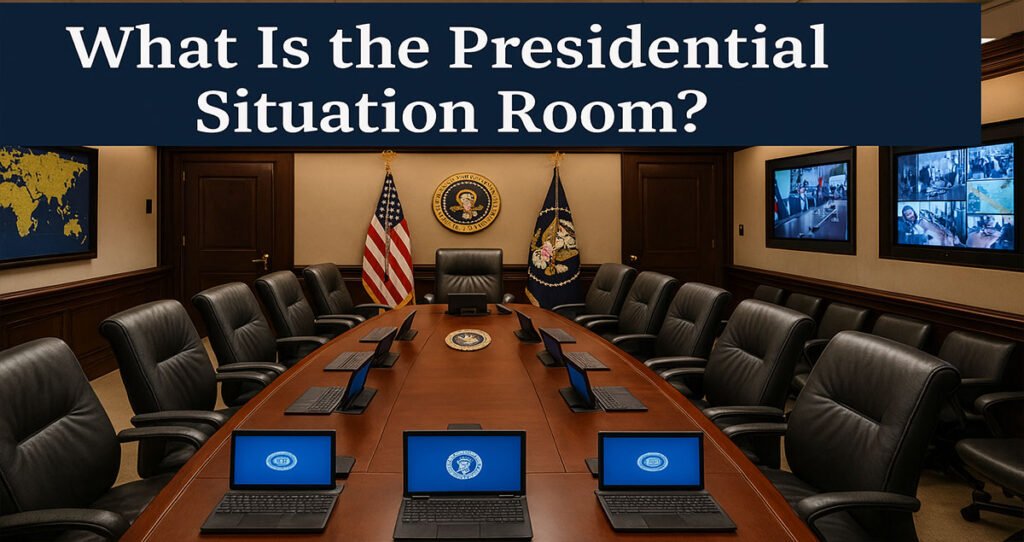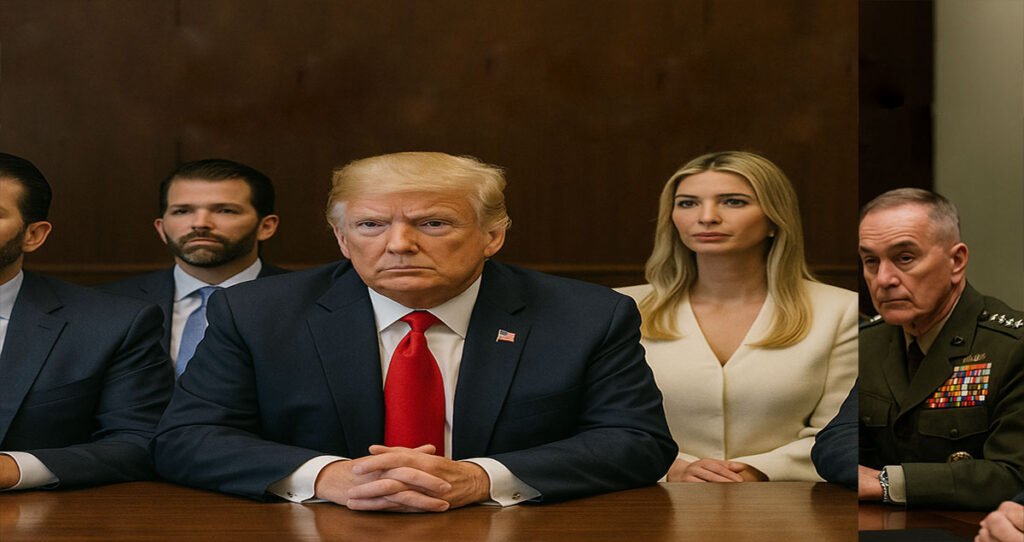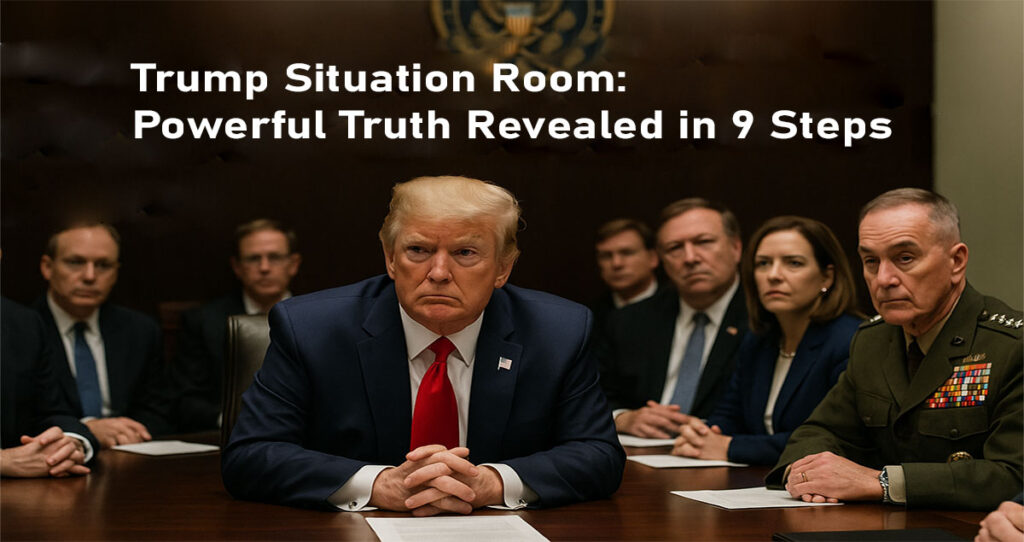The Trump Situation Room became a hot topic in politics. It showed how presidential choices, media views, and public attention meet. This look breaks down nine important facts about how Trump used the Situation Room. It covers major moves like the Baghdadi raid and some controversial photo ops. Knowing this helps explain how presidents now handle communication, crises, and social media’s role in transparency.
What Is the Presidential Situation Room?
Most people didn’t think much about the Situation Room before Trump’s time. This is a highly secure location in the West Wing of the White House, which received wide publicity all of a sudden. It started appearing in the press, on social media, and in family chats.

What made Trump’s use of this room different? It was how open he was. He didn’t keep things as secret as past presidents did. Instead, he let the public get a closer look, turning the room into a place for storytelling and showing leadership.
Usually, the Situation Room is where presidents make tough calls with military and intelligence chiefs. Under Trump, it also became a tool for politics and public image. This changed how Americans see presidential decisions.
This shift was no accident. It matched how presidents now talk to the public and handle the news. Trump’s way of using the room set new rules for openness and messaging that future leaders will face.
Step 1: The Architecture of Presidential Decision-Making
The Situation Room in Trump’s time had the latest tech but also a new style of leadership. The physical room got upgrades, but the biggest change was how choices got made.
Trump ran the White House like a business. He liked talking face-to-face instead of reading long reports. He often spoke directly with top military and intelligence officials. This made decision making faster and unpredictable at times.
The room had big screens for live video and secure calls. But Trump used the room’s tech mostly for showing his involvement. His team took many photos and videos to tell a story of strength and urgency.
Trump sometimes skipped the usual chains of command and spoke right to the people in the field. This quickened talk but sometimes made organizing harder.
Step 2: Media Strategy and Public Perception
Trump changed how the Situation Room looked to the public. Past presidents shared a few pictures now and then. But Trump made sharing images part of the routine.
The photos weren’t random. Each one was picked to show leadership, focus, and openness. Lighting, faces, and body language were planned to create a strong message.
This approach got a lot of attention. Pictures from the room spread fast on TV and online, building Trump’s image as active and hands-on. Still, it caused debate.
Security experts worried about sharing sensitive details, while political rivals accused the administration of focusing more on image than real work. Such reviews brought about bigger discussions on where transparency stops and display of politics starts in the current government.
Social media provided the Trump team with direct access to the people so that they could avoid common channels of news filtering. It is a powerful tool that influenced the story but also raised large questions related to honesty and responsibility.
Step 3: High-Profile Operations and Their Documentation
The operation to eliminate the ISIS leader Abu Bakr al-Baghdadi was one of the most unforgettable moments in the Situation Room during the time of Trump. Photos showed Trump and his team watching the operation live. These images showed the seriousness of the moment and how focused everyone was. Unlike past presidents, Trump’s team shared these pictures almost right away, showing a clear choice for instant public engagement.

The success of the raid gave these images more weight. They weren’t just made for show—they showed real decisions happening in real time. Other missions, like those in Syria and Yemen, were also photographed. But the results in those cases were mixed, revealing some risks in sharing so much during or soon after missions, especially when they later stirred debate.
World leaders, both friends and foes, noticed this openness. Some praised it. Others worried about what it meant for security and diplomacy.
Step 4: Controversies and Staged Photography Debates
Still, questions surfaced about the photos’ truthfulness. Were some staged? Did they capture the moment, or are they meant for political gain?
Critics picked apart things like lighting and angles, with some saying photos might mislead. Most extreme claims of fake images were disproved, but the debate showed how much people distrust official messages. The administration said this was a step toward being more open. Supporters agreed but also said some pictures teetered between giving info and putting on a show.
This raised bigger questions about truth and how we see politics through pictures. In the current society, where judgments can be made within seconds based on pictures, it is important to question what exists. Around the world, these photo debates changed how people saw America. Some saw honesty; others saw manipulation. It showed how the media can shape what others think of a country.
Step 5: Social Media Integration and Real-Time Communications
A major transformation in the Trump Situation Room was how he utilized social media and the Twitter tool in particular during live events. Trump tweeted updates even while things were happening, changing how presidents normally communicate.
These tweets gave the public a real-time look and let the administration control the story before news outlets could react. This made things feel immediate and personal, but raised worries about safety and diplomacy. Could a tweet spoil a mission? Would allies get the wrong idea?
The administration put rules in place to balance sharing quickly and keeping things safe. They tried not to give away anything that could hurt operations or relationships. This new style set a new bar for future presidents. They’ll have to choose whether to keep using social media this way or go back to older, slower methods. Leaders around the world started following Trump’s tweets for updates, turning presidential posts into a global news source—and sometimes a source of tension in diplomacy.
Step 6: Trump Family Involvement and Unconventional Participants
Trump’s Situation Room meetings often included family members and close personal advisors. It was notable that Melania Trump attended some of the sessions. The president liked to have trusted people around, even in national security talks. This broke with tradition. It showed a more personal side of decision-making, but raised doubts. Critics asked if these outsiders were fit to be involved. They worried personal ties might sway serious choices. Photos of these moments got mixed reviews. Some saw a human touch; others thought it crossed a line. Even outside the U.S., people watched closely. They wanted to understand how steady and structured U.S. choices were.

Step 7: Off-Site Operations and Mar-a-Lago
The Situation Room does not always need to be in the white house, as Trump has proven. Many key actions happened at other spots, like Mar-a-Lago. This showed how modern tech allows leaders to work from almost anywhere. But holding sensitive talks at a private club raised red flags. Critics pointed out security risks and confusion between personal and official work. Still, these remote sessions usually worked well. That proved results matter more than location. It also opened a tricky path for future presidents. They might like this freedom, but must keep tight security and trust.
Step 8: Entertainment and Public Reaction
The images from Trump’s Situation Room quickly turned into memes and jokes. People online and on TV shows made fun of the intense scenes. This mixed politics with entertainment in a new way. Political moments turned out to be a source of viral content. It depicted the current trend of the consumption of news and humor in conjunction. Around the world, viewers joined in. While many enjoyed the humor, some worried about taking serious matters lightly.
Step 9: Legacy and Long-Term Implications
Trump changed how presidents share crisis moments. Future leaders face the challenge of being open while keeping strategies safe. Showing real-time reactions gave the public a peek behind the scenes. But it also brought questions about how well the plans were working. The use of photos, videos, and social posts will shape how presidents act going forward. On the world stage, this new openness shifted how others see American power. Allies and rivals alike adjusted to these fresh habits. Americans now expect to see the president actively involved and visible during emergencies. This raises the pressure for leaders to balance honesty with good decisions.
Conclusion: Understanding Modern Presidential Leadership
Trump’s Situation Room highlights a key change in how presidents lead during crises and talk to the public. It reflects bigger changes in media, what people want, and what running a democracy demands today.
The nine-step analysis shows how technology, politics, and public relations meet in today’s government. Trump’s approach, full of new ideas and controversies, will influence the presidency long after he leaves office.
The Situation Room became more than just a place to make decisions. It turned into a symbol of leadership in a world where communication happens fast and is public. Future leaders must learn from this and find the right mix of openness, security, and public trust.
Looking Ahead: The Future of Presidential Crisis Communication
Looking to the future of how presidents handle crises, digital communication will keep changing. The Trump administration turned the Situation Room into a place with strong visuals and stories, showing a shift in how leaders work in the spotlight. This mix of politics and media will only get more complicated.
Presidents will have to connect with the public quickly, not just in emergencies but every day. People want leaders who are real, open, and fast, but also honest and effective. Getting this balance right will need smart communication tools, good media skills, and a clear sense of what the public thinks.
Building Trust in a Visual Era
Building trust today means more than looking good. Leaders must be real and steady. They need to share images and messages carefully while keeping communications safe and easy to reach. This approach helps leaders gain trust at home and abroad.
The Trump Situation Room showed how powerful and risky quick storytelling can be. Presidents have to know when to be seen and when to work quietly. In tough times, showing strong and thoughtful leadership across all channels is more crucial than ever.
Institutional Safeguards and Policy Evolution
To keep up, agencies like the National Security Council and the White House Communications Office must change, too. Creating rules about when to release news, how to use social media, and how to handle photos will help leaders avoid problems while staying open.
Clear rules are also needed for family roles, decisions made outside official sites, and how national security matters are shown to the public. These rules should reflect fairness, responsibility, and respect.
Global Influence and Soft Power
The way presidents demonstrate leadership in the Situation Room not only influences the people of America, but it also impacts the entire world. Images from these moments add to America’s influence. They shape how allies trust the U.S. and how rivals measure its strength. Well-planned public displays, even when secure, can be as powerful as any speech or meeting.
Final Thoughts: A Lasting Transformation
In the end, the Trump Situation Room isn’t just history. It marks a change in how presidents lead and how people remember them. It set new rules for how leaders use images and media.
Future presidents won’t just get rooms and jobs—they’ll inherit a new way of communicating shaped by technology, public demand, and media reach. Whether through photos, tweets, or live video, how a president responds under pressure will shape both their policies and their image.
This is not only because it is what you say, but also how, when, and where you display it. Where formerly the Situation Room was a place of guarded secrecy, today it is a set of continuing performances of American power, responsibility, and leadership.






